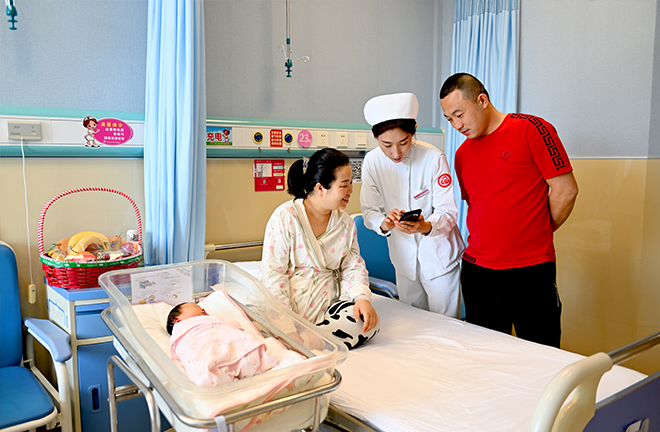Examining China’s distinctive family development policy

In March 2025, the People’s Government of Hohhot, Inner Mongolia Autonomous Region, issued the “Implementation Opinions on Promoting Population Aggregation and Advancing High-Quality Population Development,” offering childcare subsidies of 10,000 yuan, 50,000 yuan, and 100,000 yuan respectively to families who have their first, second, and third or more children and register their household registration in Hohhot. Photo: IC PHOTO
At present, declining fertility rates and rapid population aging have created mounting economic and social challenges across much of the world. Family policy is increasingly viewed as a crucial tool in responding to these shifts. Since the early 21st century, international organizations such as the UN, the EU, and the OECD have underscored the significance of family policy, framing the family as a vital source of economic vitality. In 2011, China formally introduced the concept of a “family development policy” in its “Twelfth Five-Year Plan for National Population Development,” charting a distinctive trajectory for its family policy. However, amid ongoing discussions, certain fundamental concepts require further clarification.
Debate over family policy
In Europe, family policy has existed for over a century and reemerged as a priority on the political agenda in the 21st century. However, its definition remains contested, largely due to its inherently multidimensional nature: it is both an extension of the private sphere and a tool of public governance; it embodies traditional ethics while being subject to modern deconstruction; it must establish universal rules while accommodating diverse demands.
While the traditional nuclear family—heterosexual marriage with children—is still upheld by conservatives as the only legitimate family structure, it has been challenged by growing diversity in household forms. Should non-marital families, single-parent households, and multigenerational households be eligible for policy support? Practices vary across countries. While family policy in Europe and North America tends to focus on the nuclear family, in East Asia, extended families, such as three-generation households, also represent a category that family policy cannot overlook.
The goals of family policy are manifold and sometimes conflict with each other. For instance, while extending maternity leave can alleviate families’ childrearing burden, it may also result in various “motherhood penalties” such as career disruption for women. Generous family benefits may help sustain higher birth rates but can also strain public finances and spark debate over intergenerational equity.
‘Family development policy’ tailored to Chinese context
China’s “family development policy” aims to strengthen core family functions and enhance capabilities across a range of areas, including prenatal and postnatal care, education, child development, risk resilience, reproductive health, family prosperity, and elderly care, thus achieving national development and family well-being in a reciprocal fashion.
To address the challenges of declining birth rates and population aging, family development can strengthen families’ inherent dynamism. To promote high-quality economic and demographic growth, it emphasizes investment in human capital starting from the family level. To innovate social governance, it aims to catalyze community dynamics and promote a coordinated governance model linking the state, families and individuals.
China’s adoption of the term “family development policy” instead of “family policy” reflects a developmental logic in public governance. It embodies both instrumental rationality—empowering families to mitigate demographic pressures and maintain social stability—and value rationality—reaffirming families’ crucial role as the bearer of cultural continuity and social cohesion. This approach sets China apart from the high-tax, high-benefit family policies of social democratic nations and the “refamilialization” or “maternalization” trends seen in parts of Eastern Europe. It also avoids the fiscal risks associated with unsustainable welfare systems, opting instead for a shared-responsibility model between state and family.
As China’s birth rates continue to decline and population aging intensifies, “childbirth support policy” has gained increasing prominence in the evolution of Chinese family policy. In 2022, the term “childbirth support measure” was first introduced in China’s “Guiding Opinions on Further Improving and Implementing Active Childbirth Support Measures.” Since then, it has frequently appeared in policy documents and media reports, representing an umbrella term for policies encouraging childbirth, such as expanded childcare services, extended parental leave, and tax reductions. In contrast, “family development policy” has received less attention in recent policy discourse.
However, the two are not mutually exclusive, but rather complementary. “Family development policy” emphasizes the overall functioning of the family and the construction of social support networks, whereas “fertility support policy” entails targeted interventions to boost birth rates. While emphasizing the importance of “fertility support policy,” the construction of “family development policy” must not be neglected, as the latter provides the foundation for the former and creates a more family- and society-friendly environment for its implementation. An effective “fertility support policy” should be embedded within a broader framework of family capacity building. Integrating the two is more conducive to achieving long-term demographic balance and the modernization of social governance.
Ma Chunhua is an associate research fellow from the Institute of Sociology at the Chinese Academy of Social Sciences.
Edited by WANG YOURAN
